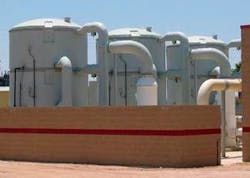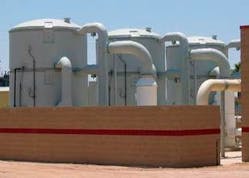Plant and operations management at a 6 mgd wastewater treatment plant (WWTP) and water reclamation facility (WRF) in Casa Grande, AZ, have reported elimination of odor complaints through installation of a 9000 cfm biofiltration system.
The selection of the biofiltration technology instead of an initially planned wet chemical scrubber option was driven by strong opposition from operations personnel concerned about chemical handling burdens and hazards. A successful pilot test alleviated their engineering firm’s doubts about the packaged biofiltration system’s ability to handle the plant’s peak hydrogen sulfide loading.
The BiocubeTM biofiltration system, currently operating at about 6000 cfm, was installed as a three-tower unit at the headworks in 2005. Concentrations of H2S entering the system typically range from 300-800 ppm. In recent actual odor log data for one of the towers, covering a seven day period, H2S entered at an average of 329 ppm, and exited at an average of 3.5 ppm. The system is manufactured by Biorem Technologies of Guelph, ON.
The installation was part of a major plant expansion designed by Carollo Engineers of Phoenix, AZ, and was recognized with a 2005 Engineering Excellence Honor Award from the American Council of Engineering Companies of Arizona (ACEC-Az).
The 6 mgd, extended aeration WWTP/WRF typically operates at about 4 mgd from October/November through April/May, when it drops to 3-3.5 mgd. The plant was originally established in the early 1970s as an aerated lagoon with facultative ponds and floating aerators. When a 1986 upgrade added a clarifier and sand filter, the county Odor Abatement Easement was at 1000'.
When design for a 1995 expansion was begun in 1992-93, the easement was still 1000’. While a headworks building and corresponding odor control system and building was originally included in the design, it was not regarded as a major issue, due to little development close to the plant. With budget limitations also a factor, the building and odor control were left out at that time.
“The first real odor complaints started just about the time that 1995 upgrade was finished,” said Jerry Anglin, wastewater superintendent for the City of Casa Grande. “The complaints were directly related to the direction the wind was blowing, and also were happening at the beginning and towards the end of the summer season, when it was not hot enough to keep people inside.”
“By the time planning started for our 2005 upgrade in 2003,” he said, “the easement was down to 300’, and odor control was now a major issue.”
Anglin said there have been no odor complaints at all since the 2005 installation of the full-scale system, and that maintenance needs and costs have been minimal.
“We routinely check H2S ourselves, with a dedicated, portable, in-line meter, and are typically showing 300-800 ppm going in and practically nothing coming out,” he said. “Meanwhile, the only extra maintenance has been some blower belt replacements, which are probably due to our high ambient temperatures here.”
“We only had to call the vendor once, when we first went on line and some media came through and plugged up the drains, but that turned out to be just a little sloppiness when the contractor was loading the trays for the first time.”
The system consists of nine cells, each containing three trays of media, set up as three towers of three cells each. Design flow per cell is 1000 cfm. The three towers were installed over the 48" influent pipe on the south side of the headworks building. Each tower is currently adjusted to handle an equal volume of about 2000 cfm, with option to increase to 3000 cfm each as the plant’s customer base continues to grow.
Biocube provided blueprints for a local contractor to set concrete pads; install control panels; connect blowers to pull the odorous air stream through the cells; connect circulating pumps for the misting system, humidifiers, and drains; and connect potable water feed. They returned to set up the towers, taking about a week, and to perform startup. A ground level vault houses four influent pumps, and the entire installation is walled off, with some perimeter landscaping for additional screening.
Belt-driven blowers were used instead of the direct-drive types typically provided by the biofilter manufacturer. Dave Williams, chief operator for the WWTP, said the blower belts have been changed twice.
“During the first year, we replaced the belts for two of the three towers,” he said. “We’ve also replaced one temperature sensor. We lube the blowers on a routine basis with the rest of the plant. The water basin for the humidifier needs flushing every couple of weeks to prevent algae buildup. That takes less than an hour for all three towers, and is purely preventive.”
“We’re supposed to have to replace filters for the misting system pumps in each tower once a year, but we haven’t had to do it yet, and it looks like a five minute job when we do,” he said. “We’re showing about 760 total dissolved solids (TDS) in the potable feed for the misting system humidifier.”
“Overall, if I’m feeding in 600-700 ppm of H2S, and it’s coming out tens and elevens, it’s doing a great job, and there’s been no dropoff in performance. We put an odor logger in-line each week, and take it to a computer to build a 7-day graph. We see spikes in the readings when a tower drops out for a drain cycle. We’re probably eliminating 99% or more of the H2S at least 80-85% of the time. In any case, we have stopped having any odor complaints at all for our plant.”





